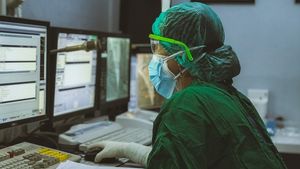JAKARTA - NASA and its international partners continue to make progress on the manned Artemis mission to the Moon by developing hardware for the Space Launch System (SLS) rocket.
The rocket will later be used on Artemis II, III, and IV missions that are already in various production, assembly, and testing phases.
The SLS proved to be the most powerful rocket in the world, when two rocket boosters and four RS-25 engines generated more than 8.8 million pounds in liftoff to send the Orion spacecraft past the Moon and back to Earth on the Artemis I mission.
Data from SLS' first flight, can help NASA scientists build confidence in rocket systems to fly crews safely on future Moon missions.
"The power given by the SLS rocket will allow astronauts to explore further in our Solar System than ever before and find more about the Moon, Mars, and its surroundings," said SLS program manager John Honeycutt, quoted from NASA's official website, Monday, February 13.
"NASA is on the verge of a new era of space discovery, and our SLS team and partners are more focused than ever on producing and producing SLS rockets for the Artemis mission that will place boots on the Moon over the next few decades."
The SLS rocket that powers the Artemis II and III missions to the Moon will use Block 1 configurations with Interim Cryogenic Propulsion Stage (ICPS).
Starting with Artemis IV, the SLS rocket will evolve into a stronger configuration, called Block 1B, replacing ICPS with a more dynamic Exploration Upper Stage (EUS) for indoor propulsion sending crew and large cargo to the Moon.
Furthermore, NASA and Boeing, the main contractors for the core SLS stage are also building 212 feet high for Artemis II, III, and IV at NASA's Michoud Assembly Facility in New Orleans.
Meanwhile, the core stage of Artemis II is in final assembly. Once the engine parts are combined with four other elements, NASA scientists will dismantle and install each of the four RS-25 engines to the stage and then prepare them to be sent to the Kennedy Space Center (KSC) runway in Florida.
Technicians will simultaneously prepare the core stage assembly and equipment activities for the Artemis III Moon rocket, parts of the engines have been delivered to the KSC in December 2022.
Simultaneously, scientists at Michoud continued all manufacturing activity and core-stage production for the five main elements of the core stages of Artemis III and IV.
Both the SLS adapter, namely the cone-shaped vehicle launch stage adapter (LVSA) and the Orion (OSA) stage adapter, were made and fully produced in Marshall.
The adapter serves as an important connection point on the SLS rocket. With the completion of the LVSA Artemis II, NASA scientists will focus efforts on the LVSA for Artemis III. The OSA for Artemis II and III has completed the painting and is being prepared for the installation of the final hardware.
Starting with Block 1B configurations, the interim cryogenic propulsion stage, launch vehicle stage adapters, and the Orion stage adapter is replaced by the Upper Phase of Exploration and Interstage, which includes the Universal Phase Adapter (USA).
Dynetics and Beyond Gravity, the main contractor adapter, is finalizing a full-scale US demonstration test article at the facility in Decatur, Alabama.
With the Artemis mission, NASA will land the first woman and first person of color on the lunar surface and carry out a long-term exploration there in preparation for a human mission to Mars.
NASA's SLS and Orion spacecraft, along with the human landing system and Gateway in orbit around the Moon, are NASA's cornerstones for deep space exploration.
The English, Chinese, Japanese, Arabic, and French versions are automatically generated by the AI. So there may still be inaccuracies in translating, please always see Indonesian as our main language. (system supported by DigitalSiber.id)








